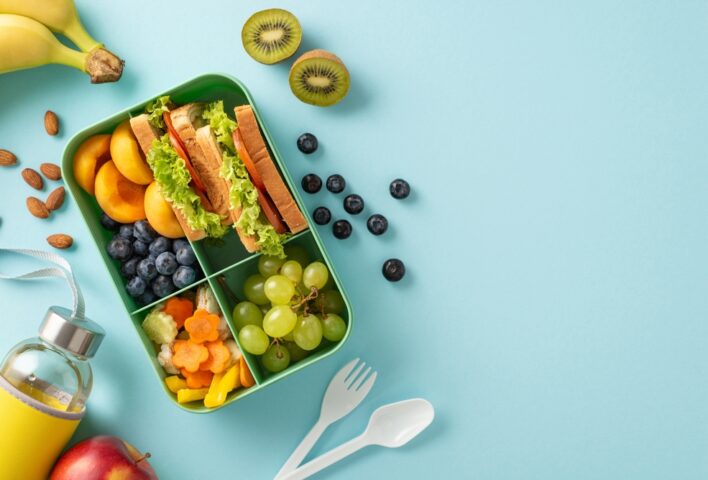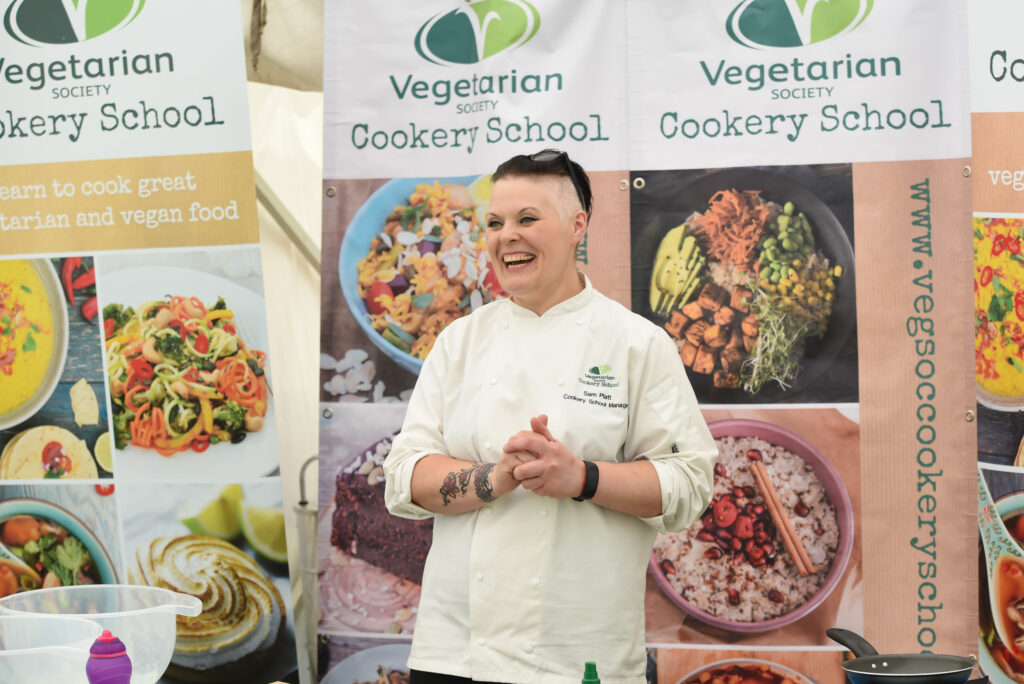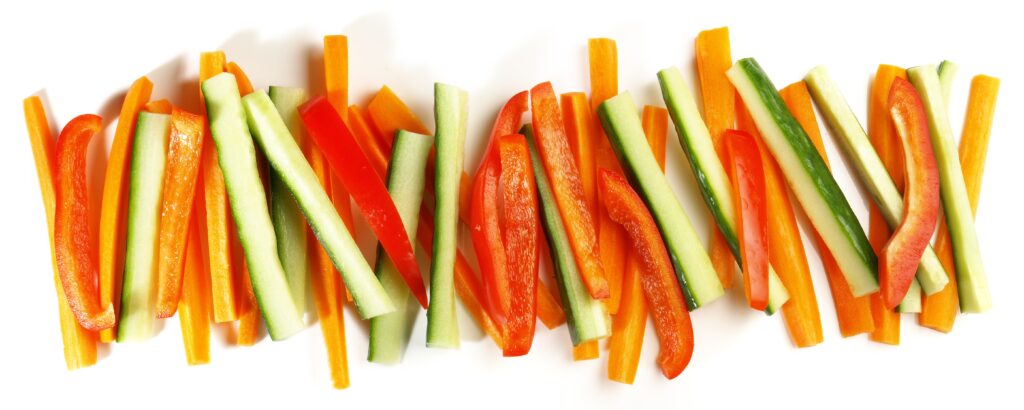Back to school – the meat-free way
From lunchbox recipes to top tips for navigating school meals the meat-free way, we take a look at how to make the return to school hassle-free and veggie-filled this autumn.

Words: Kayleigh Rattle
Whether it’s PE kits, pencil cases, name tags or uniforms, there’s a whole host of things to think about when preparing for your child to go to school. And then there’s the subject of food; how do you determine your child is eating well, and enough?
Whether you’re bringing your child up to be vegan or vegetarian, or they’ve decided to turn plant-based independently, you’ll want to ensure they’re eating the right nutrients and a well-rounded diet, in and out of the classroom.
Here, we speak to Sam Linford-Platt, Head of COOK! with the Vegetarian Society and dietitian Rachael Hunter for some top tips for navigating the school year the meat-free way.
Going green
With 4.7% of the UK population estimated to be vegan and 5.8% vegetarian, it’s hardly surprising that many children are choosing to turn meat-free too. In fact, one in five children are thought to be, or would like to be, vegan.
Given the backdrop of the cost of living crisis and the rising costs of food bills, financial considerations may be one explanation for the increasing number of families turning meat-free, or reducing their meat intake. In fact, a study by Oxford University found that in the UK and several other countries, a vegetarian diet can reduce costs by between 17% and 27%.
On top of this, children – as well as adults – are becoming increasingly aware of the environmental impact of consuming meat, plus there are cultural and religious reasons to consider why school children may be vegetarian or vegan.
But what can we do to ensure our little vegetarians and vegans are eating well
at this age, both in and outside of school?
“Key nutrients to consider include iron, calcium and B12,” explains dietitian Rachael Hunter. “Good iron sources include beans, pulses and lentils, fortified breakfast cereals, dried fruit like apricots and figs, and dark green vegetables. Calcium is vital for bone health, and at this age they are building their bone mass that will support them through the rest of their lives. It’s good to aim for around three servings of calcium-rich foods a day (such as milk, yogurt and cheese). If using plant-based milks, you’ll need to check the label to make sure they contain added calcium. B12 is found in dairy, eggs and fortified breakfast cereals. Most children will get enough from a balanced diet with these in, however if your child only likes a limited number of foods, or is vegan, you may need to consider an age-appropriate supplement.”

“Key nutrients to consider include iron, calcium and B12.” Rachael Hunter, registered dietitian
Beyond the school gates
It’s estimated the average UK-based school-age child eats around 190 school lunches in an academic year. Of these, children will typically have the choice between hot meals and packed lunches.
In recent years, household names such as Jamie Oliver and Marcus Rashford have campaigned to revolutionise school dinners in terms of both offering and accessibility. And for schools (and parents) keen to see educational institutions bolster their plant-based options, the Vegetarian Society’s School Catering
Training offers schools the chance to accommodate the growing numbers of vegetarian and vegan school-age children, by increasing the number of plant-based options on offer. School Catering Training works with schools and councils across the country to teach catering staff how to make sustainable and cost-effective plant-based recipes, as well as how to build protein into
veggie and vegan dishes and give students healthy options filled with protein, fruit and veg.
If your child or children are starting school and opting for school meals, you may find that they encounter certain foods for the first time, or refuse to eat foods they typically enjoyed before. But try not to panic, recommends Rachael. “We need to try new foods a number of times before we can be sure whether we like them or not – and the same goes for adults, too. If you want to expand your child’s diet, eating together outside of school can be a great way to do this. It can be you both try something new, or they have a ‘safer’ meal but they get to see what you are eating and try some too. Aim to make it relaxed and fun.”
Plant-based pack ups
According to a major survey by The University of Leeds in 2020, fewer than two in every 100 packed lunch boxes eaten by children in English primary schools met nutritional standards. So what can we do to ensure we’re feeding our veggie and vegan school-aged children the right foods – and that they’ll want to eat what we’ve packed them?
“Look to build a balanced offering in terms of types of food, textures, and flavours,’ recommends Sam Linford-Platt, Head of COOK! with the Vegetarian Society. “Anyone with school age children will be all too familiar with how fickle children’s tastes can be.”
With a primary-age veggie son to pack lunches for, Sam knows how daunting it can be for parents. But considering flavour and texture are two great starting points, she says.
“Try to mix things up a bit. Think about how all the items make up one
complete meal, and aim to make sure there’s a range of flavours as well as textures, such as crunch and creamy. For example, if you have a creamy soft cheese wrap, pair it with a crunchy fruit snack.”
Another top tip from Sam is to plan ahead. Of course, we’re all going to have those mornings where we’re rushing around the house trying to make sure our child is cleaned, dressed and fed, but planning ahead where possible can help to minimise stress. “I like to have fruit and vegetables chopped and ready
to go in air-tight containers in the fridge,” says Sam. “It makes it easy to grab some and pack the lunchbox. If you have time, you could make a batch of flapjack or granola bars at the weekend to give as a treat during the week. I often deliberately cook enough to make leftovers so I can use these in lunches – try cooking some extra wholewheat pasta or noodles at dinner, for example, to
make a pasta or noodle salad for the next day.”
But as we know, while we may try our best to provide our children with a varied and nutritional packed lunch box, our little ones may not always be on board. Sam recommends getting them involved and letting them have a say (to an extent!)
“Children may be more inclined to eat all of their lunch if they have some choice in it,” suggests Sam. “I sometimes let my son put together a couple of lunches from a few possible choices. He chooses one type of protein, one type of wholegrain, fruit and veg, and one thing from the treat box. He gets the lunches he wants, but I still know he has all the things he needs to be full and healthy!”

“Anyone with school age children will be all too familiar with how fickle children’s tastes can be.” Sam Linford-Platt, Head of COOK! with the Vegetarian Society. Photo: Tangerine Event Photography
Wholesome homework
Whether your child is opting for hot school meals or a packed lunch, kickstarting the day with a nutritional breakfast at home can help fuel them for the school day ahead. “A safe bet is to choose a high fibre, low sugar, fortified breakfast cereal,” says Rachael. “Serve with milk, some fruit or a small glass of
fruit juice. This will give them a good dose of vitamins and the iron in the fortified cereal will benefit from the vitamin C in the juice or fruit as
it will boost its absorption. Another thing that can help fill children up in
the morning is adding protein, such as scrambled eggs on some seeded
toast – if there is time of course!”
And what about when your children are back home from school, tummies rumbling as they rummage through the cupboards looking for a snack? You’ll no doubt want to feed them something that will sustain and nourish them but not impact their dinner. “Popcorn, houmous, roast pepper wraps, flapjack, or a handful of baked pretzels are some of the after school snacks we turn to,” Sam says. “It’s always something easy and something that’s ready to go. I make sure I have healthy snacks on hand so they don’t reach for an easy (but unhealthy) snack instead.”
Term-ready
The hot meals are booked, the packed lunches are packed, and the book bag is waiting by the door. Any final words of advice from our experts?
“Meals, snacks, and support in schools unfortunately vary widely. Make sure your school knows that your child is veggie or vegan,” suggests Sam. “Reminding them at the start of each school year is a good plan. When it comes to school trips, special days and activities such as forest school, no child likes to feel like the odd one out. Speak to your school in advance and make sure wherever there may be food or treats, there is an option for your little one
too.”
“Children’s tastes come and go,” adds Rachael. “Try not to panic if they suddenly go off their favourite food, or decide that they no longer like a certain vegetable. Providing overall they have variety and you are satisfied they are eating enough to enable their body to grow, trust that it will pass. The Vegetarian Society’s Vegetarian Eatwell guide is a great resource to look at with your child. You can look together to see what areas you could include more of to add balance. I would always focus on what to have more of, rather than what to cut out.”

Carrot, cucumber and pepper sticks are a great snack option for your child’s lunchbox
Plant-based lunchbox ideas
Stuck for ideas? Sam Linford-Platt recommends choosing from some of the following:
- Protein
- Houmous
- Chickpeas
- Cooked marinated tofu pieces
- Cheese
- Cooked peas
- Cooked quinoa
- Wholegrains
- Wholegrain wraps
- Wholegrain crackers
- Wholewheat pasta or noodles
- Brown rice
- Fruit and veg
- Sweetcorn
- Cooked broccoli
- Carrot sticks
- Cucumber sticks
- Apple
- Kiwi
- Treats
- Greek yogurt and honey
- Flapjack bar
- Wholegrain muffin
- Popcorn
- Rice cakes
Resources
https://www.bbc.co.uk/newsround/58653757
https://www.britishscienceassociation.org/blog/back-to-school-lunches-is-now-the-time-to-go-veggie
https://www.thelancet.com/journals/lanplh/article/PIIS2542-5196(21)00251-5/fulltext#seccestitle180
join us for just £3/month for more articles!

This is an article featured in the latest issue (Summer/Autumn 2024) of our members’ magazine The Pod.
To read more articles, please sign up to become a member of the Vegetarian Society and get your copy of our Summer/Autumn 2024 magazine! Joining us costs as little as £3 a month.
